Tales of the Unexpected: Thames Exchange TEX88
Gustav Milne
Looking in the Wrong Place
The Billingsgate Lorry Park excavations had top billing in the DUA calendar for 1982-3. It was seen as the last major waterfront excavation in the City,
and its deep and well stratified waterfront deposits would finally resolve that nagging continuity question of Roman/Saxon interface. But the results, although spectacular in their own right, raised more questions than answers, showing that this central section of the London waterfront was largely undeveloped from the late Roman period to the 11th century. Instead of clo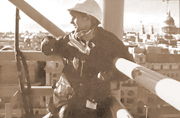 sing the gap between Roman and Saxon occupation, it actually widened it.
sing the gap between Roman and Saxon occupation, it actually widened it.
Was Londinium really deserted for 500 years or more?
We had been looking in all the wrong places. Just two years later, our sister unit (Dept of Greater London Archaeology) showed that from 7th to late 9th century, our Saxon ancestors had settled in the Covent Garden area, a couple of miles west of the abandoned Roman town. This was a seismic shift in our understanding of London’s history. But the earliest evidence for reoccupation of the intramural area, we now know, didn’t come for central sites near London Bridge but from the Queenhithe/Vintry waterfront. It was discoveries by a new generation of DUA excavations in the late 1980s, like the Thames Exchange site, that recorded 9th- 10th century riverside developments, in the newly-founded Saxon city. The next puzzle was that archaeological deposits in this part of town were assumed to have been destroyed by 1960’s rebuilding. So what went wrong, or rather, what went right?
Doom and Gloom
The publication of The Future of London’s Past in the summer of 1973 had a powerful influence on the City’s archaeological management. It not only stressed the crucial importance of the City’s waterfront sites, but stated that by 1983 the archaeological deposits along the waterfront will have been lost and that by 1993 at most, much of the City undeveloped since 1945 will also have been destroyed (Biddle et al 1973, 8.3).
We Should Be So Lucky…
Working with that miraculous agency known as hindsight, we now know that the report’s predicted timeline proved less than accurate: archaeological excavations in advance of rebuilding works continued well into the 21st century. There were two understandable reasons for the ten-year Doomsday scenario propounded in 1973. One reason was the unexpected deregulation of the City in 1986, the so called “Big Bang”, transforming how the City functioned. It acted as a strong magnet for international bankers to work here, new companies that needed new offices that could cope with new electronic trading practices. This was the driver for many major redevelopments on a previously unanticipated scale.
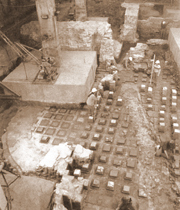 The second reason was that FoLP referred to the planning applications for the demolition of pre-war waterfront buildings and their subsequent reconstruction: by the late 1980s, most of those buildings had indeed been swept away. What had been assumed is that the construction of multi-storey buildings built in the 1950s and 1960s would have destroyed all the underlying archaeological levels.
The second reason was that FoLP referred to the planning applications for the demolition of pre-war waterfront buildings and their subsequent reconstruction: by the late 1980s, most of those buildings had indeed been swept away. What had been assumed is that the construction of multi-storey buildings built in the 1950s and 1960s would have destroyed all the underlying archaeological levels.
But most of those post-war structures were raised up on piled foundations and some had but one basement level. So deep waterlogged strata remained largely undamaged in at least some areas of these large sites.
Thus, when those buildings found themselves subject to redevelopments 20, 30 or 40 years later, archaeologists were still able to excavate well-preserved archaeological levels beneath them. In the late 1980s, they simply transferred their attentions from the basements of 19th century warehouses to the sites of multi-storey carparks built in the 1960s.
Wet Wet Wet
One such multi-storey carpark stood on what had been Three Cranes Wharf in the Vintry, and became the thoroughly waterlogged, timber-rich Thames Exchange excavations (TEX88). This was a develop-funded project, supported by Kumagai Gumi UK. The on-site supervisors were Chrissie Harrison, Jo Stephenson and Morag Coloquon, truly a triumvirate to be reckoned with.
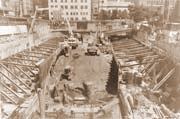 The work involved archaeologists mounting controlled excavations on the eastern part of this large 70m long site followed by a protracted “watching brief” on the western half. As was normal in those days, we didn’t enjoy sole occupancy but shared the site with piling rigs, jackhammers, muck-away lorries, mechanical excavators and the tower-crane’s securely hoisted loads.
The work involved archaeologists mounting controlled excavations on the eastern part of this large 70m long site followed by a protracted “watching brief” on the western half. As was normal in those days, we didn’t enjoy sole occupancy but shared the site with piling rigs, jackhammers, muck-away lorries, mechanical excavators and the tower-crane’s securely hoisted loads.
However, we also had access to offices in Portacabins, a welcome works canteen and contractors who, for the most part, were as accommodating and helpful as their own busy schedules allowed. We were even able to bring a small but committed volunteer team from CoLAS onto the site on more peaceful Sundays to provide much valued assistance, especially on the western front.
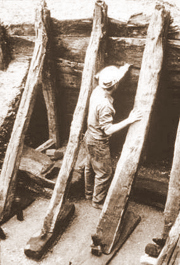 As for fashion, yellow PPE had yet to be invented, so we wore our own clothes, although hard hats and steel toe-capped boots were now mandatory. However, as the DUA had grown, so had its ranks of middle-managers, one of whom arrived for a site inspection in full office regalia including pristine (non-steel) white trainers. It was so embarrassing to insist that she could only view the site from the safety of the street. As for us, we also had visits from our very own Safety Officer, Jim Allen, who checked that our ladders were firmly lashed and footed, and that unsupported sections were indeed supported.
As for fashion, yellow PPE had yet to be invented, so we wore our own clothes, although hard hats and steel toe-capped boots were now mandatory. However, as the DUA had grown, so had its ranks of middle-managers, one of whom arrived for a site inspection in full office regalia including pristine (non-steel) white trainers. It was so embarrassing to insist that she could only view the site from the safety of the street. As for us, we also had visits from our very own Safety Officer, Jim Allen, who checked that our ladders were firmly lashed and footed, and that unsupported sections were indeed supported.
Before the main works began, the contractors dug a very narrow slit trench all around the extreme perimeter of the site to insert a watertight diaphragm wall. This preliminary activity was most carefully monitored by Kieron Tyler, who plotted the locations of timberwork plus any associated ceramics observed in the upcast. This produced a clear guide to where the alignments of major riverfront revetment would be, as well as their potential dates, an essential predictive tool, invaluable for programming the later controlled excavations.
 Being used to the standard sequences on sites like Billingsgate in the east of the City, we anticipated a sequence of 11th to 15th century extensions. But, according to an assessment of Keiron’s excavation prequel, the central section of some 50m was all reclaimed in the 13th century, but there was clear evidence for several much earlier but as yet undated, encroachments to the north. Those subsequently proved to be late 9th to 12th century redevelopments incorporating post and plank revetments, rare finds indeed.
Being used to the standard sequences on sites like Billingsgate in the east of the City, we anticipated a sequence of 11th to 15th century extensions. But, according to an assessment of Keiron’s excavation prequel, the central section of some 50m was all reclaimed in the 13th century, but there was clear evidence for several much earlier but as yet undated, encroachments to the north. Those subsequently proved to be late 9th to 12th century redevelopments incorporating post and plank revetments, rare finds indeed.
Our earliest Saxon structures were built onto foreshore deposits that sealed the remains of a late Roman timber-built quay, clearly deliberately dismantled by the end of the 4th century. This was precisely the sort and length of sequence that the Billingsgate excavations had hoped to find, and showed that the once abandoned London was finally re-occupied by the late 9th century.
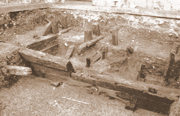 This is the late Roman timber-built quay which was deliberately dismantled in the 3th century, and then was totally covered by foreshore deposits. A signal end to Londinium’s once busy port.
This is the late Roman timber-built quay which was deliberately dismantled in the 3th century, and then was totally covered by foreshore deposits. A signal end to Londinium’s once busy port.
A Timber Building Revolution
All the earlier medieval wooden structures in the northern half of the site incorporated earth-fast posts, that is the vertical members were set in post-holes dug into the ground surface. By way of an example, this structure is of 10th century date.
But the first structure which utilised a baseplate, a quite different technology, was a timber-framed jetty feature, well to the south on the site. Amazingly, it was built in the early 13th century as an extension to a late 12th century earthfast waterfront 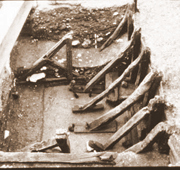 revetment (left).
revetment (left).
We were therefore staring at the very introduction of fully-framed timber buildings in London. The dendro samples later showed that this crucial transition took place between 1200, the date of the earth-fast TX4 revetment, and the TX5 jetty, which used timbers felled in 1228/9.
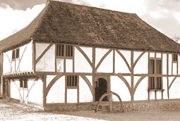 For historians, the early 13th century is famous for the Sack of Constantinople or the signing of Magna Carta: but for archaeologists and architectural historians, it should be better remembered as the period that first gave us the wonderful box-framed building.
For historians, the early 13th century is famous for the Sack of Constantinople or the signing of Magna Carta: but for archaeologists and architectural historians, it should be better remembered as the period that first gave us the wonderful box-framed building.
Time of our Life? Richard III wasn’t the only archaeological feature found under a car park. The Thames Exchange multi-storey was a site that kept on giving: there was the late Roman quay, the largest assemblage of Saxon quernstones in London, the footings of an 11th century waterfront warehouse, a unique boarded walkway over the foreshore at the southern end of College Hill.
Richard III wasn’t the only archaeological feature found under a car park. The Thames Exchange multi-storey was a site that kept on giving: there was the late Roman quay, the largest assemblage of Saxon quernstones in London, the footings of an 11th century waterfront warehouse, a unique boarded walkway over the foreshore at the southern end of College Hill.
In addition we found many disarticulated frgaments of boats and ships. This clearly represents the site of a Saxon shipyard where vessel building, vessel breaking and vessel repair were all being conducted, evidence for another major industry on the Thames waterfront.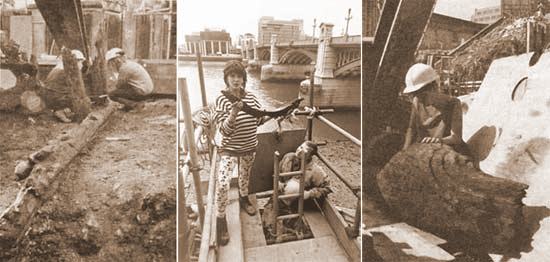 There was plenty to photograph here and although we still didn’t have mobile phones, we used (for us) the new technology of Pagers, which provided a hotline to the DUA’s responsive photographers.Here was a site well-worth some publicity, which we tried to drum up for the developers. The trouble was, media attention strayed elsewhere- a Roman bath-house threatened with destruction at Huggin Hill and, even worse, the remains of a 16th to 17th playhouse over the river in Southwark. The latter, in particular, began to hog the headlines as the long-running saga of the Rose Theatre took off. Saxon
There was plenty to photograph here and although we still didn’t have mobile phones, we used (for us) the new technology of Pagers, which provided a hotline to the DUA’s responsive photographers.Here was a site well-worth some publicity, which we tried to drum up for the developers. The trouble was, media attention strayed elsewhere- a Roman bath-house threatened with destruction at Huggin Hill and, even worse, the remains of a 16th to 17th playhouse over the river in Southwark. The latter, in particular, began to hog the headlines as the long-running saga of the Rose Theatre took off. Saxon 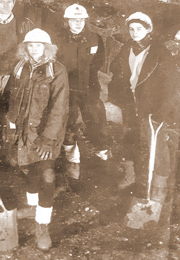 London just couldn’t compete with Shakespeare. This eventually became, not just a one-off story, but another Baynard’s-Castle-1972 moment: it was one of the prime catalysts for another seismic change in archaeological practice that exploded onto the stage in 1991. Planning Policy Guidance Note 16 might not sound dramatic or revolutionary but it most certainly was, for London archaeology and for the DUA it changed everything, signalling the end of our particular world. We didn’t know it at the time of course: we just kept on digging, but for me (and many others) these were the last City excavations we would ever work on.
London just couldn’t compete with Shakespeare. This eventually became, not just a one-off story, but another Baynard’s-Castle-1972 moment: it was one of the prime catalysts for another seismic change in archaeological practice that exploded onto the stage in 1991. Planning Policy Guidance Note 16 might not sound dramatic or revolutionary but it most certainly was, for London archaeology and for the DUA it changed everything, signalling the end of our particular world. We didn’t know it at the time of course: we just kept on digging, but for me (and many others) these were the last City excavations we would ever work on.
An Ending
And then there was a terrible event that really put things into perspective.  In August 1989, our on-site post-excavation Portacabins were set on the waterfront directly overlooking the Thames foreshore. And it was there, right in front of us, that the carcass of the pleasure boat the Marchioness was hauled up after its tragic sinking in the early morning of the 20th August, with the loss of 51 lives. Crowds of relatives and friends would gather on Southwark Bridge to commiserate: it was hard to focus on the site matrix.
In August 1989, our on-site post-excavation Portacabins were set on the waterfront directly overlooking the Thames foreshore. And it was there, right in front of us, that the carcass of the pleasure boat the Marchioness was hauled up after its tragic sinking in the early morning of the 20th August, with the loss of 51 lives. Crowds of relatives and friends would gather on Southwark Bridge to commiserate: it was hard to focus on the site matrix.
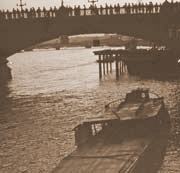 This sad scene is the image I still most strongly associate with TEX88: ironically that poor ship had been the very one used for a boat trip to celebrate the 1985 book launch for The Port of Roman London.............
This sad scene is the image I still most strongly associate with TEX88: ironically that poor ship had been the very one used for a boat trip to celebrate the 1985 book launch for The Port of Roman London.............



Comments powered by CComment